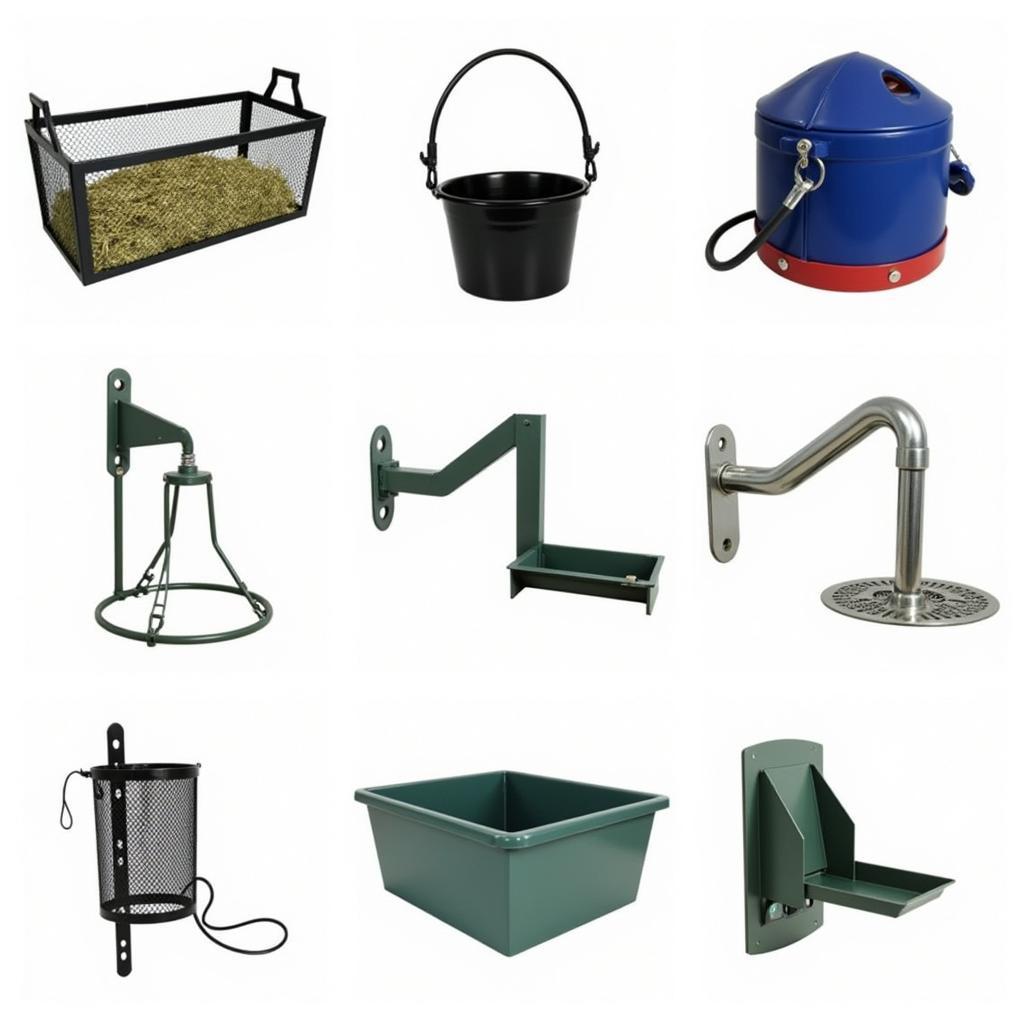Feeders For Horse Stalls are an essential part of equine management, impacting not only your horse’s nutritional intake but also their overall well-being. Selecting the appropriate feeder can minimize waste, promote healthy eating habits, and prevent digestive issues. This article will guide you through the different types of feeders for horse stalls, helping you make an informed decision for your equine companion.
Picking the perfect feeder isn’t as simple as grabbing the first one you see. There’s a whole world of feeders out there, designed to address various needs and stable setups. From slow feeders that mimic natural grazing to corner feeders that maximize stall space, choosing the correct feeder can drastically improve your horse’s health and your stable management routine.
Types of Feeders for Horse Stalls
There’s a wide variety of feeders for horse stalls on the market, each with its own set of advantages and disadvantages. Choosing the right one depends on your horse’s individual needs, your management style, and the layout of your stable.
Hay Feeders
Hay feeders are crucial for providing horses with their primary source of forage. These can range from simple wall-mounted racks to more elaborate slow-feed hay nets. A good hay feeder should minimize waste, keep hay off the stall floor, and encourage natural grazing behavior.
Grain Feeders
Grain feeders are typically smaller and designed for dispensing concentrated feeds. These feeders are essential for horses who require supplemental grain in their diet. They come in various materials like plastic, rubber, and metal. best slow feeders for horses are especially beneficial for horses prone to gorging and can help prevent choke and other digestive upsets.
Slow Feeders
Slow feeders for horses encourage natural grazing behavior by limiting the rate at which a horse can consume its feed. This helps prevent boredom, reduces the risk of digestive problems, and promotes a healthier eating pace. horse hay feeders for stalls are a great example of slow feeders for hay. They can be nets, boxes, or even specially designed hay racks that make it more challenging for the horse to access the hay quickly.
Material Matters: What Are Horse Stall Feeders Made Of?
The material of your horse stall feeder is just as important as its design. Each material has its pros and cons regarding durability, safety, and ease of cleaning.
Plastic Feeders
Plastic feeders are lightweight, easy to clean, and relatively inexpensive. However, they can be less durable than other materials, especially if your horse is a kicker.
Rubber Feeders
Rubber feeders are durable, non-toxic, and often have rounded edges, making them a safer option. They can be more expensive than plastic but offer better longevity.
Metal Feeders
Metal feeders are the most durable option, but they can be heavy and potentially rust over time. Galvanized steel feeders offer a good balance of durability and rust resistance. best horse feeders are often made of durable, high-quality materials like galvanized steel.
Where to Place Feeders for Horse Stalls
Strategic placement of your feeders for horse stalls can further enhance their effectiveness.
Corner Feeders
corner horse stall feeders are designed to fit snugly in the corner of a stall, maximizing space and minimizing the risk of the feeder being knocked over. This is particularly beneficial in smaller stalls.
Wall-Mounted Feeders
Wall-mounted feeders are another space-saving solution, keeping feed off the floor and reducing waste. They also prevent horses from pawing or playing with their feed.
Expert Insights on Feeders for Horse Stalls
“The right feeder can significantly improve a horse’s digestive health,” says Dr. Emily Carter, Equine Nutritionist. “Slow feeders, in particular, are invaluable for preventing gorging and promoting a more natural eating pattern.”
“Choosing a durable material is essential,” adds stable manager, John Davis. “A well-made feeder can withstand years of use, even with the most enthusiastic eaters.”
Choosing the Best Feeder: Key Considerations
When selecting feeders for horse stalls, consider your horse’s individual needs and your stable management practices. “Observe your horse’s eating habits,” suggests Sarah Miller, Certified Horse Trainer. “This will help you determine the best type of feeder to suit their needs.” hay slow feeders for horses are excellent for horses that tend to eat their hay too quickly.
Ultimately, the best feeders for horse stalls are those that prioritize the horse’s well-being, promote healthy eating habits, and simplify stable management. By carefully considering the factors outlined in this article, you can make an informed decision and provide your equine companion with the optimal feeding experience.
Conclusion
Feeders for horse stalls are a crucial investment for any horse owner. By carefully considering the type, material, and placement of your feeder, you can significantly impact your horse’s health, well-being, and overall quality of life. Choosing the right feeder is a small change that can make a big difference.
 Various horse stall feeders for different needs.
Various horse stall feeders for different needs.
Need help with feeders for horse stalls? Contact us at Phone Number: 0772127271, Email: [email protected] Or visit us at QGM2+WX2, Vị Trung, Vị Thuỷ, Hậu Giang, Việt Nam. We have a 24/7 customer service team.